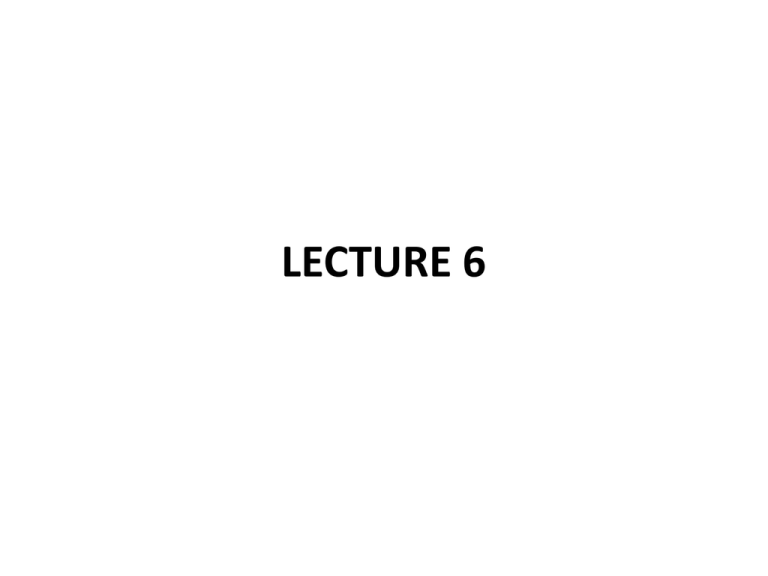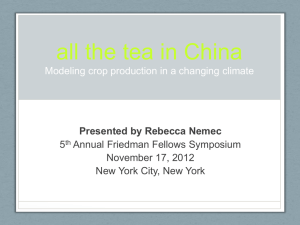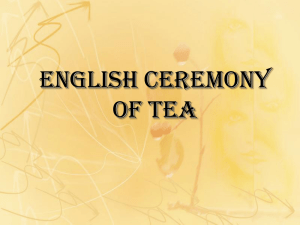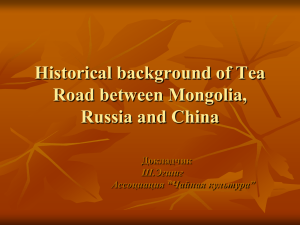TEA (CAMELLIA SINENSIS (L) O. Kuntze)
advertisement

LECTURE 6 TEA (CAMELLIA SINENSIS (L) O. Kuntze) Protective Effects Of Tea On Human Health Flavonoids, the most prominent of which is catechins and their derivative polyphenols, are the most abundant and most biologically active molecules that are responsible for most of the health-giving properties of tea. Tea contains theanine, (which is a unique amino acid in tea), proteins, caffeine, vitamin C, carbohydrates, polysaccharides, and lipids. Inappropriate diets and smoking generates high levels of reactive oxygen species, like peroxides in humans, which are the basic cause of heart disease. Tea polyphenols have strong scavenging properties for free oxygen radicals, thus lowering the risk of heart ailment. Cancer is as a result of uncontrolled proliferation of cells mutated by oxidative stress or carcinogens in foods and environment. Tea polyphenols induce enzymes that detoxify carcinogens, thus inhibiting cancer initiation or carcinogenesis of cancer tumours. Catechins, (particularly, epigallocatechin) interact with an enzyme in human intestines to suppress glucose uptake, by inhibiting sodiumdependent glucose transporter mechanism, thus preventing diabetes. Protective Effects Of Tea On Human Health Contd. Kidney diseases are the results of free radical-induced oxidative stress, tea catechins relieve high oxidative stress, improve renal blood circulation and are effective in easing the pains caused by renal diseases. Osteoarthritis is also prevented by tea polyphenols through inhibition of the production of catabolic mediators implicated in the progression of arthritis. Theanine and catechin which are the component of green tea has neuro-protective effects, thereby preventing cerebral stroke. L-Theanine in tea has been reported to effectively control flu-like symptoms of the common cold. Anti-viral and anti-bacterial properties of tea reduce influenza, infections of respiratory tract, and lungs as well as preventing pulmonary diseases. Protective Effects Of Tea On Human Health Contd. Tea also raises basic metabolic rate, so that at equal food intake and exercise levels, body weight is reduced for those who drink 8 – 10 cups of tea a day. This explains why fewer Japanese are obese. Black tea polyphenols prevent tooth-removing diseases and dental plaque formation. Tea contains 20 – 30 mg of caffeine per 100 ml and daily caffeine intake must not exceed 600 mg/day which is equivalent of 2 – 3 litres of tea/day. Even fruit-flavoured teas contain normal caffeine as green / black tea. Normal green / black tea does not provide any calorie / energy, but fruit-flavoured teas may contain traces of sugars, thereby providing few calories. Herbal infusions do not contain calories. Introduction Tea plant (Camellia sinensis (L) O. Kuntze) (family: Theaceae) was discovered by Chinese around 2700 BC in South-east Asia, in the high valley of the Brahmaputra, the Irrawaddy, the Salween and the Mekong rivers of the borders separating India, China and Burma. In its wild state, it forms an evergreen bush which on cultivation, is kept at a low level (Tea Table) (Plate 1) to enable the young shoots, from which tea is made, to be plucked. Today, tea is cultivated in China, Japan, India, Sri Lanka, Indonesia, South American Countries, High altitude regions of Africa, Middle East, Australia and Russia. Depending on weather the tea harvests (leaves) undergo fermentation or not, respectively, makes tea to be black or green. The black tea is orange to dark-red in colour which sometimes gives scented infusion. It contains low level of Catechins (4.0 g/100g) and high level of Theaflavins (0.94 g/100g). The green tea, on the other hand, gives insipid beverage with yellowish colour and it contains highest level of Catechins (14.2 g/100g) and zero Theaflavins. Plate 1: Plantation of Tea (forming a Tea Table) Botany Tea was formerly named Thea japonenense. Later Linnaeus renamed it Thea sinensis. In 1959, the generic name was changed to Camellia. The plant is a diploid with 2n = 2x = 30. A number of triploids and tetraploids have been found or created by research efforts. There are 2 main varieties of tea – the sinensis (the China plant with small leaves C. sinensis var. sinensis) and the assamica (the Assam plant with large leaves C. sinensis var. assamica) varieties. The assam tea plant is a shrub which grows up to 15 m high with straight trunk. The China tea is also a shrub which grows up to 6 m high with several stems. Other minor varieties include Cambodian tea, of which the following varieties are being cultivated – Manipuri, Lushai and Betjan which are stable ecotypes. Ecology Of Tea Climate and soil characteristics are the most important ecological factors for growing Tea: CLIMATE: Tea thrives under equatorial, humid and temperate climatic types. Generally, tea thrives within latitude 430 north and 270 south. Assam tea is less hardy than the China variety which tolerates dry season and lower temperatures. The plant performs under 1500 – 4000 mm of rainfall, with a dry season of not more than 3 months. Around the Equator, tea thrives under 1800 mm rainfall but, with altitude of between 1800 – 2000 m asl. The dry season must not be less than 3 months. Ecology Of Tea Contd. CLIMATE Contd: The ideal average annual temperature is between 180C and 200C. The growth of tea plant is seriously affected at 300C and 120C and tea plant dies at 50C. It does not tolerate frost. Sunshine hours of 5 hours per day, on the average, is required by tea. In cloudy conditions and heavy and continuous rainfall, the yield drops. The tea plant thrives under high relative humidity of between 70% – 90%. This is favoured by permanent shade, windbreaks or irrigation by spraying. In dry air, the bud becomes dormant and the plant stops growing. Ecology Of Tea Contd. Soil requirements: Geological origin does not greatly affect the development of tea plant. Generally, the best plantations of tea are found on deep soils with a good structure, well-drained with a well-developed humus-bearing layer and high mineral reserves. Quaternary soils, recent alluvial soils, soils on granite or gneiss and soils derived from eruptive rocks or volcanic ash are suitable for tea growing . The tea plant requires acid soils with pH of between 4.5 – 5.5, if the pH is not up to 5.5, it is better. The tea plant performs badly on alkaline or compact soils. Tea is generally grown on well-drained sloping terrain, but the slope must not be more than 25% - 30%,unless land improvement carried out effectively checks soil erosion. Agronomy Of Tea Propagation of tea: Generative and Vegetative. Generative propagation: Tea plantations from seeds result in heterogeneous vegetable materials, which result in great variations in production, quality and suitability for fermentation. The seed-bearing tea bushes are left to grow freely for seed production. Alternatively, the young and vigorous tea plants, in the nursery, are selected for the purpose. After a number of selections upon generations in the garden, high producers are selected while poor producers are eliminated. This method is used to obtain varieties best suited to ecological conditions of each region (high yield and superior organoleptic qualities being traits of interest) Agronomy Of Tea Contd. Vegetative Propagation: Tea plant is widely propagated by layering, grafting, stem cuttings and root cuttings. Tea clones are widely produced by stem cuttings which is simplest and widespread. Selection of best tea bush for cloning is based on 2 primary characters: the yield and quality of liquor. Secondary characters include sprouting rate of cuttings, fermentation suitability and tolerance to dry conditions. Selection is generally done on the field, but at times it may be carried out in the nursery. Agronomy Of Tea Contd. Tea Nursery: The following principles should be adhered to in setting up cuttings nursery of tea: Siting: It must be sited very close to perennial source of water source of substrate and well-sheltered from wind. Shading: Tea nursery must be shaded and the shade covering should be 2 m above the ground which must allow 20% - 30% light penetration. Substrate: The substrate should be of clay sand composition with little organic matter and crumbly structure. It must have a pH of between 4.5 - 5.0. Containers: The substrate is placed in transparent polythene bags perforated at the base. Transparent bags are preferable to black bags because, they are not expensive, absorb less heat, dry slowly and enable root development to be monitored. Agronomy Of Tea Contd. Tea Nursery Contd. Preparation of tea Cuttings: Cuttings are taken from semi-hard stems, preferably when the weather is overcast. They are packed in plastic bags and moistened. Cutting are prepared, at an angle of 450, in a well-ventilated place sheltered from sun, using a budding knife. The cuttings consist of a leaf, a bud and a stem of 3 – 4 cm long. At times, multinodal cuttings are used because they are more vigorous and easily root, but, they involve more vegetative parts. The cuttings are placed inside a bucket of water and transported to destinations. The stems are planted upright or slightly bent. Agronomy Of Tea Contd. Tea Nursery Contd. Maintaining humidity levels: After planting, the materials are sprayed with water droplets and covered with polythene sheet of 150 – 400 microns thick to form an humidity chamber. Preventive measures: The humidity chamber must be continually checked for constant humidity levels and the outbreak of disease and insect pests. Fertilizer application: This starts when most of the cuttings have successfully rooted and when hardening-off begins. The recommended fertilizers are ammonium sulphate, urea or compound fertilizers (2 – 30g/m2) Hardening-off: This begins as soon as cuttings have rooted (2 – 4 months after setting). The polythene sheet is gradually removed over a period of 2 – 3 weeks and the shading is slowly removed, according to climatic conditions. Pruning: This is not recommended in the nursery because it slows down root development. Rapidly-developing clones are sometimes pruned. Agronomy Of Tea Contd. Guide towards successful establishment of Tea plantation: Sit selection land clearance Drainage Anti-erosion measures Eradication of self-propagation weeds Tilling Agronomy Of Tea Contd. Tea plantation: Planting out: Only sturdy seedlings / ramets with stem diameter of 8 – 10 mm are selected for transplanting into the field. The weak and less vigorous seedlings are destroyed and on no account will they be replanted the following seasons. Planting density / spacing: The optimum planting spacing of tea plant depends on its vigour, canopy, width of its plucking table, and soil fertility. Planting density in determining factor in calculating the yield of tea plant. Temporary shading: When young, tea plants have to be protected from sun, drying winds and hail by hedges of leguminous plants (Crotalaria, Tephrosia, etc). The hedgerows are retained for 1 – 2 years before tea starts giving harvests, but hedgerows are regularly pruned and pruned vegetation supplies organic matter to the soil. Agronomy Of Tea Contd. Tea plantation contd. Mulching: Mulching is of great importance to development of young tea plants. It protects the soil from sun’s rays, drying winds, reduces evaporation and affords adequate moisture retention during the dry season. It checks run-off, muddy situation in heavy rains, temperature extremes and improves soil organic matter. 20 – 40 tonnes/ha of grasses (Pennisetum purpureum, Digitaria spp. and triosacum laxum) are recommended for tea cultivation. Windbreaks: Windbreaks are essential, particularly in exposed regions at high altitudes. The species normally used include Hakea saligna, Grevillea robusta, Accacia spp., Cupressus spp., Eucalyptus spp. and even tea itself. Agronomy Of Tea Contd. Bringing Tea into bearing / yield: The main aim of bringing tea plant into bearing is to shape the plant into a permanent frame which is low, broad, heavily branched and capable of producing a large number of shoots (Tea Table), culminating in a high leaf yield. Formative pruning is mostly used in tea culture. The axillary buds are stimulated by cutting-off the main stem to a certain height, thereby forming a wide frame / canopy. In formative pruning, the first operations come up in the nursery. The main stem is cut-off at an height of 10 – 20 cm from the ground, with secateurs. The second pruning is done, on the field, at an height of 30 cm while the third is carried out when the young tea plant attains 40 cm without any plucking being made. These operations form the tea table. Agronomy Of Tea Contd. Plucking: This is the periodic harvesting. The pluckers are equipped with an apron or waterproof against damp conditions and rains. Plucking may be carried out manually (by hand) or mechanically (tea harvesters) The young shoots that appear above the plucking (tea) table is plucked The harvests in tea consist of a bud and 2 – 3 leaves Harvests in tea is to strike a balance between yield and quality. The chemical elements that determine quality in tea are found in greater quantity in the young shoots. Never pluck non-adult shoots (buds and buds + 1 leaf) in order to obtain a short plucking round and a high yield. Agronomy Of Tea Contd. Plucking Contd. Plucking round depends on climatic conditions. The average plucking round is 10 days. The plucking extremes are 6 – 14 day. Never adopt a fixed plucking round. Never pluck shoots under the plucking table Pluck the dormant bud in order to encourage the axillary buds to open Pluck an minimum of 75% of good leaves (bud + 2 leaves, bud + 3 leaves and dormant buds + 1 young leaf). Only pluck shoots recommended by the factory head who is responsible for the quality of the commercial product. Keep the plucking table horizontal and parallel to the ground. Agronomy Of Tea Contd. Productivity pruning: Productivity pruning is carried out when the plucking table rises so high and plucking becomes practically difficult and thus, yield falls. The period of the operation of productivity pruning varies from 2 – 6 years depending on climatic conditions and clonal materials planted. This pruning operation comes up at the end or beginning of rains and is done with a pruning knife. The level of pruning is parallel to the ground and at a predetermined height. All branches above the height are cut-off while the frame under this height limit are left intact. Agronomy Of Tea Contd. Regenerative pruning: When plucking table becomes to high to perform productivity pruning, regenerative pruning becomes inevitable. Regenerative pruning is carried out at 0.35 m from the ground and tipping is done at an height of 0.60 m. Skiffing (cutting into green wood): This is carried out when plucking table rises quickly, becomes very irregular or damaged by hail or frost. The plant is slightly cut back in order to maintain a good yield. This type of cutting is rarely required. Agronomy Of Tea Contd. Fertilizer requirements of tea: Annually and for a yield of 1000 kg/ha of commercial-grade tea, the plant takes up an average of 40 – 50 kgN, 7 – 9 kgP and 20 – 25 kgK from the soil. Leaching is another avenue of nutrient loss in tea plantations, especially in mountainous regions. The quantity of fertilizer to be applied should be calculated accordingly. Weeding: The young tea plant is very sensitive to weed competition. Regular weeding (manually or chemically) becomes compulsory. Disease and Insect pests of Tea Diseases: Root rot (Armillariella mellea, Rosellinia arcuata). Common in forested land. Symptoms: It slows down growth of young tea plant Leaf chlorosis Excessive flowering Leaf wilting Eventual death of tea plant Blister blight (Exobasidium vexans): Very dangerous leaf infection Translucent to light brown spots, with pink or red spots at the centre. Blisters at the underside of leaves When the blisters burst, infection continues. The affected shoots later die. Disease and Insect pests of Tea Insect pests: The leaf insect pest of tea include: Homona coffearia Urticating caterpillars Helopeltis spp. Aphids The branch insects pest are: Xyleborus fornicatus Zeuxera coffeae Termites (Neotermes, Glytotermes, Coptotermes) Mites (Oligonichus coffeae or red spider)









